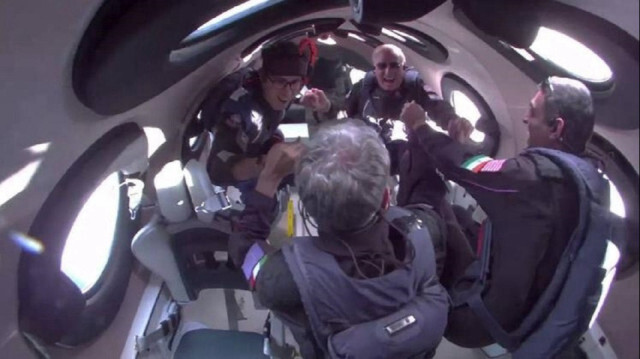
Virgin Galactic's 70-minute mission ends after landing on Earth
Virgin Galactic's VSS Unity, carrying a six-person Galactic 07 mission team including the second Turkish space traveler Tuva Cihangir Atasever, successfully took off for a suborbital space flight from the US state of New Mexico.
The blastoff was at around 8.30 a.m. local time (1430GMT) with a total of six crew members, also including three astronauts — two American and one Italian — and two pilots.
Atasever will serve as a research astronaut aboard the spacecraft's final flight, designated Galactic 07.
The flight is expected to last about 60-90 minutes, with the VSS Unity to reach an altitude of roughly 45,000 feet (over 13,700 meters) on a carrier aircraft; it will then activate its hybrid propulsion system to rise to approximately 55 miles (90 kilometers).
Atasever will be conducting seven scientific experiments under microgravity conditions during the roughly three-minute free-fall phase.
- Atasever's experiments
Just before the takeoff, Turkish President Recep Tayyip Erdogan wished Atasever success. "We are excitedly following the work of our astronaut who will carry out seven scientific experiments," Erdogan said on X.
Atasever will wear a modified astronaut suit equipped for three experiments, including the "Beacon" brain imaging experiment.
This experiment uses a near-infrared spectroscopy device on his head to examine blood flow in the brain's prefrontal cortex and cerebrospinal fluid dynamics. Additionally, samples from Atasever will be collected to study psychological changes from viewing Earth from space.
The IvmeRad Radiation Dosimeter experiment will measure radiation exposure, aiding in predicting future exposure for space travelers in real time.
In the Space Insulin Pen Test, a collaborative project between the Turkish Space Agency (TUA) and Axiom Space, two different insulin pens will be used to assess dose delivery efficiency in this setting for the first time.
This will be the first test of treatment methods for future diabetic space travelers.
Another experiment, called Vesicle Analysis in Suborbital Flight, will use a specially designed microchip to analyze biological samples taken from Atasever before and after the flight. This study seeks to develop therapies to help astronauts better adapt to space travel before liftoff.
Three other experiments, Message, Metabolom, and Miyeloid, will be repeated during Atasever's flight after they were conducted during an earlier trip to the International Space Station by Türkiye's first astronaut Alper Gezeravci.
Message measured the effects of microgravity on human physiology, while Metabolom was conducted to find out the biomolecular changes induced by space flight.
Miyeloid, meanwhile, examined changes in cell groups suppressing immune system response during inflammatory diseases.
Atasever's turn touching the heavens follows premier Turkish astronaut Gezeravci's historic mission this January to the International Space Station as part of the Axiom Mission 3 mission.

